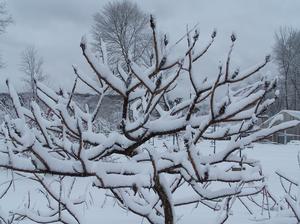Part V: Gardening for the Birds
Planning for winter interest in your landscapes is paramount for year round garden enjoyment. Luckily many winter interest plants double as food and refuge for a host of feathered creatures year round. I asked Dr. Craig which shrubs and conifers are sources of food and shelter but double as good garden plants. He mentioned all that follow.
Red cedars (Juniperus virginiana) magnanimously provide for 54 or more bird species - an outstanding number. Among them are Cedar Waxwing, Eastern Bluebird, Brown Thrasher, Gray Catbird and Northern Mockingbird. A favorite food of Pine Siskins is seed from the numerous small cones of Eastern Arborvitae (Thuja occidentalis). Common Grackles, House Finches, Robins and occasional Sparrows smartly hide their nests under cover of their evergreen foliage.
Hemlocks are the preferred nesting choice for Wood Thrush plus Blackburnian and Yellow-rumped Warblers. Chickadees love its seed. Sadly, Dr. Craig recounted the demise of so many stands of hemlock in Connecticut due to Wooly Adelgid epidemic. Michael Dirr, horticultural expert, in Manual of Woody Landscape Plants says that if he could plant but one conifer it would be Tsuga canadensis, eastern hemlock. The species has many forms available: dwarfs, miniatures, weepers, gold-needled and those with variegated foliage. Of course, it would be the larger growers which would be of interest to the birds that might frequent them.
Blackburnian Warblers tend to remain in the upper reaches of hemlocks. Their backs are boldly striped with a large patch of white on each wing. Males sport a striking orange throat, eyebrow and crown patch. In females these characteristics trend yellow. We will be seeing fewer of these warblers now that many wild stands of hemlock have been decimated.
Four seasons of interest can be found in many deciduous shrubs. For instance, staghorn sumac (Rhus typhina) has architectonic construction (see pic 1). Female forms produce red “candles” lasting through winter. There are lacy cut-leaf forms with beautiful ferny foliage during the growing season which color gorgeous to fiery shades in autumn. Sumacs will also feed Red-eyed Vireos, Robins, Catbirds and Cedar Waxwings. There are many species of cotoneaster, good-looking in all seasons that form beautiful small pomes, nature’s bounty for Rufous-sided Towee and many other flyers.
Female evergreen holly forms including any among the Meserve hybrids (Ilex x meserveae) provide both food and refuge to Robins, Catbirds, Bluebirds and Cedar Waxwings. Inkberry (Ilex glabra - see pic 2), another evergreen holly, beautiful during the bleak months, nourishes as many as 15 species including Northern Bobwhite, Northern Mockingbird and Hermit Thrush.
The providence of viburnums which are available in so very many species, forms and sizes is a godsend to Eastern Bluebird, Northern flicker, Rose-breasted Grosbeak, Red-eyed Vireo, Robin, Catbird and Cedar Waxwing (see pic 3) to mention some. They are attractive in the winter landscape but shine in spring with large showy flowers followed by fruit sets in changeable colors depending upon the species. The fall foliage show is always a treat. And after the leaves fall to the ground often can be found nests tucked in branch crotches whose previous inhabitants chose amid its dense canopy as a safe place to raise a brood.
Shrub dogwoods are a most important resource for many birds. As an example, the red-osier dogwood, Cornus stolonifera, draws approximately 18 different species, including Wild Turkey and Catbirds. They grow densely, slowly forming thickets which many songbirds use for cover and nesting. Shrub dogwoods come in numerous species, sizes and colors with both summer and autumn nourishment for a host of birds. And they double as ornamentals splendidly endowed with year round garden interest. When planted to stand down broadleaf and coniferous evergreens their stems glow in shades from deep dark red to bright corals, sunny yellows, some with brassy tones which trip the light fantastic in the winter landscape. Even thicket-forming Cornus racemosa, our native graytwig dogwood (see pic 4), is attractive but most especially in late summer when copious cymes of pearly-white fruits each dotted with a small dark eye set atop bright red pedicels occurring at branch tips while autumn foliage tones of wine-mahogany create a most handsome foil. Plant it before a backdrop of golden conifers such as Chamaecyparis obtusa ‘Crippsii’ to contrast the gray stems. Under-plant with a groundcover of bugleweed (Ajuga reptans) and you not only will complete a balanced visual display you will also attract Hummingbirds the following May when they produce striking spikes of dark blue flowers.
Highbush and lowbush blueberries (Vaccinium corymbosum and V. angustifolium) are fantastic food-producing shrubs with all-year ornamental qualities. Pretty bellflowers in spring form delicious blueberries that feed more than 34 possible takers including Orchard Oriole. The autumn foliage on all blueberries is deep, rich glowing garnet-ruby. The winter stems are generally a commendable earthen red. Plant them in acid soil in near to full sun. To be continued...


